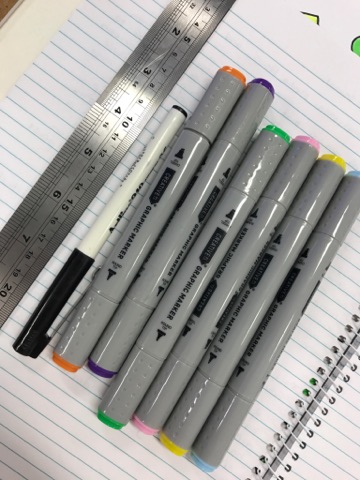Original Artworks.
Instructions:
1. In the middle of an A3 piece of paper draw a rectangle in black texta, using ruler 30cmx20cm.
2. Using the black texta and ruler draw a grid inside the rectangle with the lines 5cm apart. Do this by making markers on the perimeter 5cm apart then join with the marker directly across.
3. Turn the page to portrait if not already in that orientation, keep it this way for the rest of the drawing. Using the black texta, draw circles, triangles and rectangles all over the grid. NOTE: max of two shapes per 5×5 square and the shapes can be drawn over lines of the grid.
4. Colour the triangles pink or purple, the circles green or blue and the rectangles yellow or orange.
5. In one square on each line draw little black lines (think lots of little toothpicks which have been spilled) NOTE: They can not touch each other or overlap.
Supplies for artist:

Executions:
When deciding what type of artwork I wanted to write instructions for I was heavily inspired by 80’s style graphics. I decided that if I kept the page busy it would be more likely that my instructions will be interpreted well. I also supplied my executors with all of the supplies that was needed to complete the artwork.
Executing this style of artwork from instructions may be difficult to those who have never seen the style before or do not correlate the words of the instructions and appearance of the artwork as they go with 80’s graphics. I believe it is this reason that the executions differ so much.
Usually these kinds of works are completed digitally, which I think also may have affected the way in which my executors interpreted the instructions as these artworks are usually associated with graphic design as opposed to drawing.
The element of the artwork which was universally successful was the grid because the clear measurements and materials were given. Also the number of shapes on each drawing was appropriate, I should have somewhere in my instructions however, mentioned that the shapes should have been quite small.
Only one artist correctly interpreted the instructions regarding the colour of the shapes while the other two artists used every colour available to them on the drawing. The same artist who correctly coloured the shapes was also the only one who understood the idea of tiny little lines which replicated spilt matchsticks in one box on each line while the other two seemed to miss the concept. This fact may be down to one artist paying more attention to the instructions than others or reading the instructions in whole before beginning the artwork.
Overall, I am pleased with the executions of my artworks and it has proved very interesting to realise that there are many different ways to interpret instructions.






